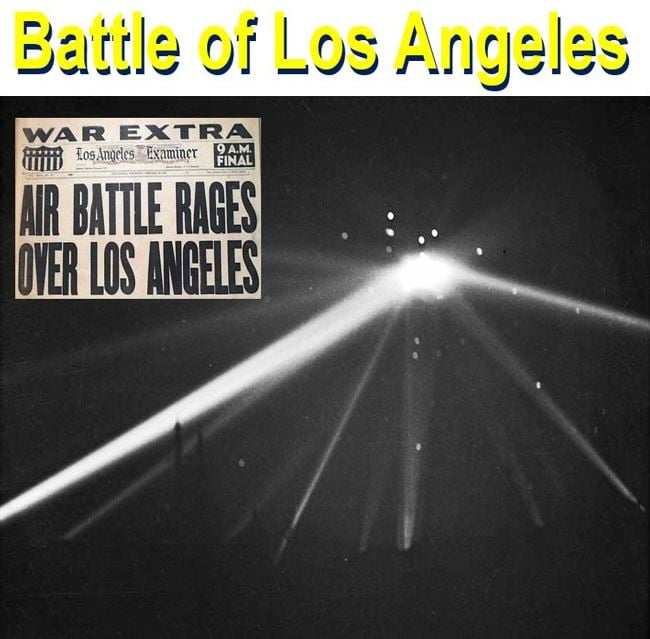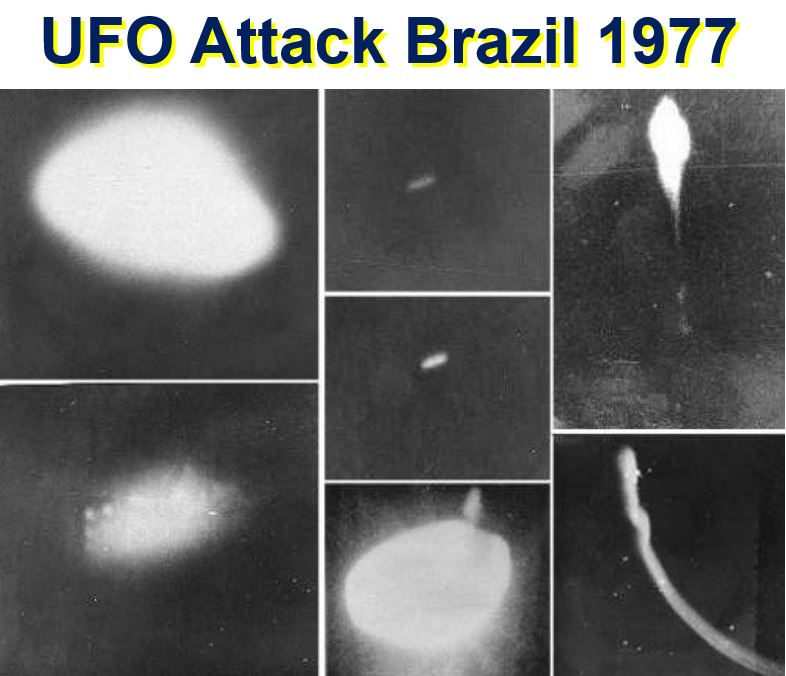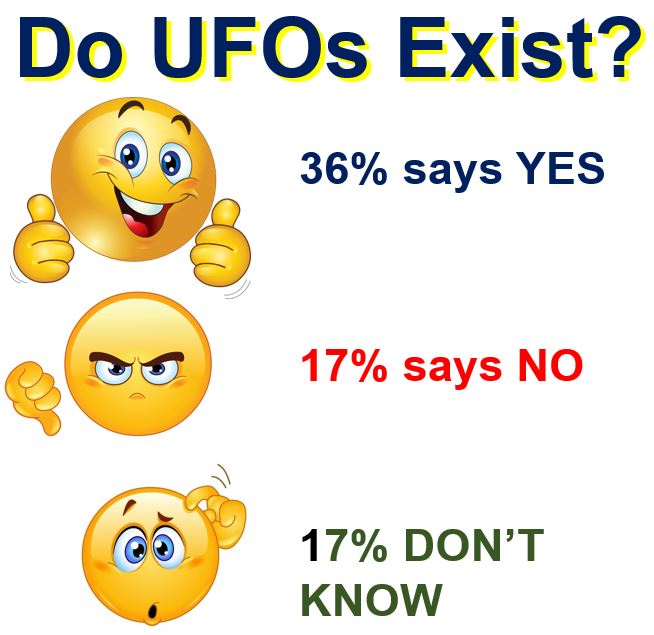A UFO, or Unidentified Flying Object is anything abnormal observed in the sky that cannot be identified as a known object or phenomenon. It is a mysterious object in the sky that catches our attention, curiosity and often our imagination. Generally, the term UFOs triggers thoughts of little green men from other planets.
The term UFO does not mean that what a person or group of people saw belonged to extraterrestrials – it simply means we do not know what it is, it is ‘unidentified’.
Often, UFOs are linked to claims of visitations by aliens from other worlds or conspiracy theories involving the government, and have become popular subjects in science fiction, as well as some reports allegedly claiming factual events.
 In 1942, anti-aircraft artillery shot into the night sky over Los Angeles from various parts of the city. Thousands saw the strange bright objects in the sky. This was 3 months after Pearl Harbor in Hawaii was attacked by the Japanese Air Force. The following day the US Navy said the incident was a ‘false alarm’. Given that the US government had a war to deal with, what those UFOs in the sky were was never properly investigated.
In 1942, anti-aircraft artillery shot into the night sky over Los Angeles from various parts of the city. Thousands saw the strange bright objects in the sky. This was 3 months after Pearl Harbor in Hawaii was attacked by the Japanese Air Force. The following day the US Navy said the incident was a ‘false alarm’. Given that the US government had a war to deal with, what those UFOs in the sky were was never properly investigated.
Many UFOs are later identified
Some UFOs later become identified, usually as lightning, a missile test, a weird cloud formation, a balloon, the planet Venus, aircraft, a military experiment, a hoax, a meteor, or something else.
When identification is not possible, it is generally because the evidence related to the UFO sighting is of low quality – perhaps the image was too blurred or dark, or the evidence was anecdotal and there was nobody else around to corroborate the story.
Even so, those 5% to 20% of all reported sightings that are not explained are, in the strictest sense, UFOs, because they have not been identified. Even if a UFO was identified as belonging to aliens, it would no longer be a UFO, because we would have found out what it was.
Stories about UFOs and apparitions of beings from other worlds or religious entities have been told for many thousands of years. However, the term UFO is fairly recent.
Origin of the term ‘UFO’
The Oxford English Dictionary says the term ‘unidentified flying object’ dates back to the 1950s. It was recorded in a book by Donald Keyhoe (1897-1988), an American Marine Corps naval aviator, and writer of many aviation articles and stories in a variety of leading publications.
Edward J. Ruppelt (1923–1960), a US Air Force officer probably best known for his involvement in Project Blue Book, a formal governmental study of UFOs, said he had invented the term as a more general one to replace the earlier description of ‘flying disk’ or ‘flying saucer’.
 In 1977, more than 400 people saw UFOs in the Brazilian city of Colares. Witnesses said the UFOs fired beams at them, causing injuries, which doctors later had to treat. People were in such a state of panic that the Air Force came in to both offer support and investigate the incident. The investigators found no proof of UFOs. (Image: therichestimages.com)
In 1977, more than 400 people saw UFOs in the Brazilian city of Colares. Witnesses said the UFOs fired beams at them, causing injuries, which doctors later had to treat. People were in such a state of panic that the Air Force came in to both offer support and investigate the incident. The investigators found no proof of UFOs. (Image: therichestimages.com)
Captain Ruppelt wrote:
“Obviously the term ‘flying saucer’ is misleading when applied to objects of every conceivable shape and performance. For this reason the military prefers the more general, if less colorful, name: unidentified flying objects. UFO (pronounced Yoo-foe) for short.”
The term ‘flying saucer’ became popular after a sighting in 1947 by Kenneth Arnold, (1915-1984), an American aviator and businessman. He said he saw nine objects in the sky flying in formation near Mount Rainer, the highest mountain in the state of Washington.
Mr. Arnold timed the objects and calculated that they were travelling faster than 1,200 mph (1,931 km/h). When describing their shape, he said they were disc-like or saucer-like. Local newspapers immediately wrote about ‘flying discs’ and ‘flying saucers’.
The idea of UFOs and extraterrestrials has always fascinated humans. It was not long after the modern term entered the English language that the number of reports of sightings started to increase dramatically.
By 1959 the term ufology entered the English language (recorded in the Times Literary Supplement). About four years later, experts in the field of UFOs became known as ufologists, even though ‘ufology’ was never regarded anywhere in the world as a proper academic discipline.
 In November 1986, Captain Kenju Terauchi was flying a Japan Air plane from Paris to Tokyo. While over Alaska, the captain, crew and passengers saw a very bright object, about three times the size of their airplane, flying alongside. Ground controllers confirmed the flying object in their radar. It was observed for over 50 minutes (300 miles). Nobody knows what it was. (Image: ufoevidence.org)
In November 1986, Captain Kenju Terauchi was flying a Japan Air plane from Paris to Tokyo. While over Alaska, the captain, crew and passengers saw a very bright object, about three times the size of their airplane, flying alongside. Ground controllers confirmed the flying object in their radar. It was observed for over 50 minutes (300 miles). Nobody knows what it was. (Image: ufoevidence.org)
After UFO new terms emerged
Because of media and public ridicule associated with the UFO topic, some serious investigators created other terms, such as UAP (Unidentified Aerial Phenomenon) or anomalous phenomena.
NARCARP, which stands for the National Aviation Reporting Center on Anomalous Phenomena, hardly ever uses the term UFO. It conducts investigations and research of aviation-related observations.
NARCARP invites pilots, air traffic controllers, radar operators and other aviation professionals to report any aviation-related observation or incident involving a UAP.
How thoroughly are UFOs investigated?
Getting the whole field properly investigated by eminent researchers is nearly impossible. Top scientists are not interested for several reasons: they have more interesting work to pursue, they don’t have the time, and they are not willing to sift through piles of hoaxes and reports lacking proper evidence.
 There are more people in America who say UFOs exist than those who believe they don’t. Figures are similar for most countries. (Data Source: http://news.discovery.com)
There are more people in America who say UFOs exist than those who believe they don’t. Figures are similar for most countries. (Data Source: http://news.discovery.com)
There is also the risk of losing prestige. An eminent scientist risks being labelled a crack-pot or emotionally unstable if he or she starts submitting articles to scientific papers and making presentations about UFO sightings.
Even astronauts worry about their career prospects. There have been cases of astronauts seeing or hearing things in space that make no sense, talking about it to each other and deciding not to tell mission control.
There was some debate in the past among scientists globally about whether any scientific investigation into UFO sightings was warranted. They concluded that the phenomenon was not worthy of serious investigation.
Government interest in UFO sightings
Scientific investigations into UFOs have occurred in the past, however, and some of them with proper scientists and government money.
 Is this ancient cave painting depicting a UFO? (Image: ufoevidence.org. Credit: History Channel)
Is this ancient cave painting depicting a UFO? (Image: ufoevidence.org. Credit: History Channel)
Governments along with reputable academics from the Soviet Union, Spain, Mexico, Uruguay, Chile, Brazil, Sweden, Belgium, France, Peru, Japan, Canada, the UK and the USA have investigated UFO reports several times over the past 100 years.
Among the best known government studies are:
– 1946-1947: the ghost rockets investigation by the Swedish military.
– 1947-1969: Project Grudge, which became Project Sign and then Project Blue Book, conducted by the US Air Force.
– 1948-1951: Project Twinkle investigation into green fireballs by the US Army and Air Force.
– 1977: Operação Prato (Operation Saucer), conducted by the Brazilian Air Force.
– Since 1977: France has had an ongoing investigation within CNES (Centre national d’études spatiales).
– Since 1989: the government of Uruguay has had an ongoing investigation similar to the French one.
Over the past couple of years, the number of alleged UFO sightings has increased considerably.
Most languages across the world use the same term ‘UFO’, except for: OVNI (French, Spanish), ユーフォー (Japanese), and 飞碟 (Chinese).
Video – UFO Documentary: Behind Closed Doors
Over 1,000 UFO sightings are reported each year. UFOs are becoming the topic of the century. Are they really out there?
